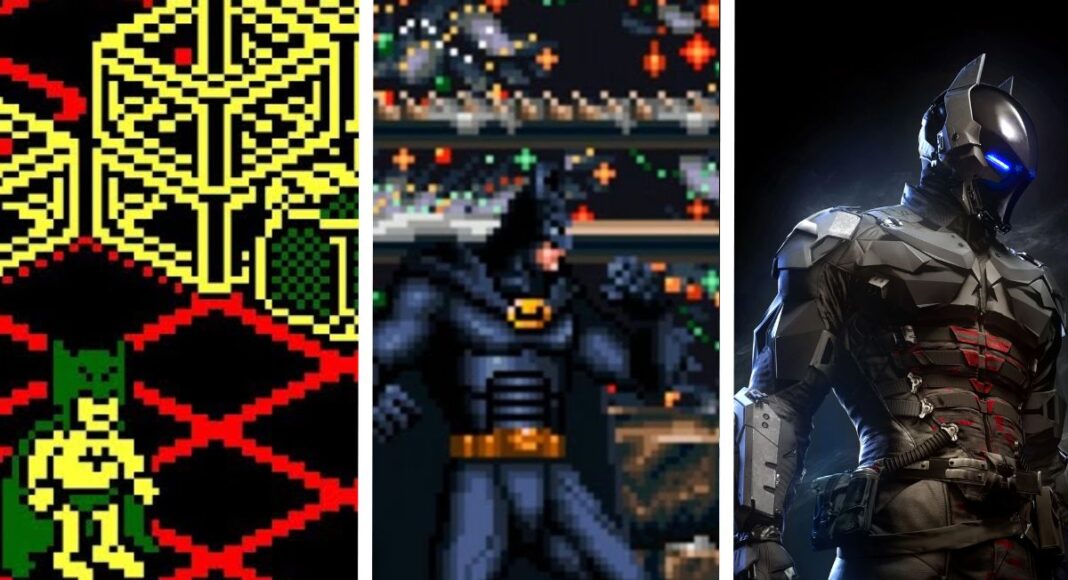Welcome to our ultimate caped crusader chronicle where we’ve meticulously laid out every Batman game in order, a journey that will take us from the pixelated streets of Gotham’s earliest digital renderings to the expansive, hyper-detailed cityscapes of more recent times. For fans of the Dark Knight’s digital outings, this compilation is the treasure map to the Batman gaming universe, revealing each title’s place in superhero game lore.
As we look at the long history of Batman games, we unearth the evolution of the Caped Crusader’s game franchise, from its arcade origins to the genre-defining experiences that followed. Each entry on our list of Batman games has been carefully selected by DC experts and gaming enthusiasts alike, ensuring a comprehensive and authoritative trek through the virtual legacy of The Bat.
Whether you’re a Bat-fanatic looking to relive the glory days or a new recruit eager to experience the legend from the beginning, this rundown is your definitive guide. And for those grappling with the conundrum of whether you’re wondering how to play the Batman Arkham games in chronological order, or simply wish to consume them as they were released, we’ve got you covered with the details you need to embark on that adventure with confidence. Find the complete history of Batman games below.
1Batman (1986)
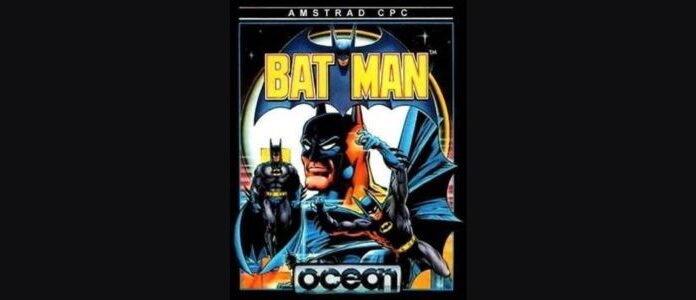
Platforms: Amstrad CPC, MSX, and ZX Spectrum
In 1986, Ocean Software plunged into the gaming scene with a Batman title that would set the stage for the iconic superhero’s digital escapades. This action-adventure game, simply titled Batman, allowed players to don the cape and cowl of the Dark Knight in a 3D isometric world, one of the first of its kind to adopt this perspective.
Developed for the Amstrad CPC, MSX, and ZX Spectrum, Batman became one of the defining titles of its era. The game captivated players with its mix of puzzle-solving and action elements, offering a gameplay experience true to the character’s detective roots. Players navigated through the labyrinthine corridors of the Batcave and other familiar locales, on a quest to piece together the scattered parts of the Batcraft that would enable the Caped Crusader to go after his nemesis, the Joker.
Upon release, Batman was met with critical acclaim, notably for its innovative use of the isometric viewpoint which was cutting-edge at the time. This gameplay style would later influence future titles across various genres. The game’s graphics and design were commended for capturing the essence of the Batman universe, and its challenges were praised for engaging the player’s problem-solving skills, thus doing justice to the World’s Greatest Detective matchless intellect.
Batman (1986) served as an impressive foray into blending superhero lore with interactive entertainment, cementing the character’s place in the gaming industry for decades to come.
2Batman: The Caped Crusader (1988)
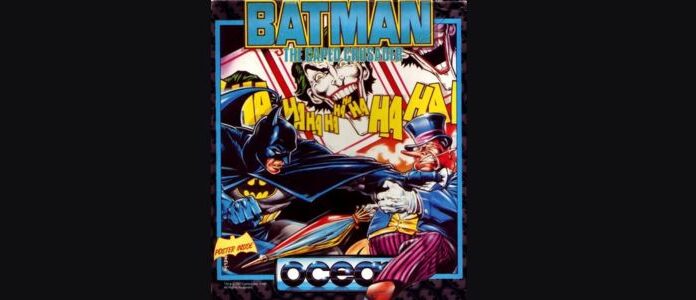
Platforms: Amstrad CPC, Apple II, Atari ST, Commodore 64, MS-DOS, and ZX Spectrum
In the landscape of early superhero video games, Batman: The Caped Crusader holds a special place, offering a pivotal portrayal of Gotham City’s masked vigilante. Released in 1988, the game was developed by Special FX Software Ltd and published by Ocean Software, a team known for pushing the boundaries of what could be achieved in comic book-inspired games at the time.
Batman: The Caped Crusader came out on numerous platforms, including the Amiga, Amstrad CPC, Apple II, Atari ST, Commodore 64, MS-DOS, and ZX Spectrum, making it accessible to a broad audience of gamers. Embracing a comic book panel transition style, the game presents two distinct adventures: “A Bird in the Hand”, pitting Batman against the Penguin, and “A Fete Worse Than Death”, focusing on the Joker’s antics. This approach rendered a visually engaging experience that mimicked the feel of flipping through a Batman comic.
Players welcomed the game’s innovative design and challenging puzzles, though some found the gameplay to be on the difficult side. Nonetheless, Batman: The Caped Crusader was generally well-received for its faithful adherence to the source material’s aesthetic and atmosphere. Its noir, detective-inspired gameplay and presentation of iconic Batman villains also garnered positive reception from both critics and fans, solidifying its legacy as a noteworthy adventure of the World’s Greatest Detective in the evolution of video games.
3Batman: The Movie (1989)

Platforms: Amiga, Atari ST, Commodore 64, MS-DOS, and ZX Spectrum
Diving into the heart of Gotham City’s dark streets, Batman: The Movie video game swooped onto the scene in 1989, riding the wave of excitement generated by Tim Burton’s blockbuster film. Developed by Ocean Software, this action-packed game allowed fans to experience key moments from the movie, delivered with a digital twist. It was released across a spectrum of platforms, including the Amiga, Atari ST, Commodore 64, MS-DOS, and ZX Spectrum, ensuring a wide grasp on the gaming audience of the era.
The game was designed as a multi-level adventure where players controlled Batman through various stages that mirrored the plot of the film. Players tackled Gotham’s underbelly, faced off against the Joker’s henchmen, and navigated iconic vehicles like the Batmobile and Batwing. Each platform presented slightly different versions of the game, exploiting their respective hardware’s capabilities to give a unique spin on the Caped Crusader’s crusade.
Critically, Batman: The Movie was received with resounding positivity. It won praise for its adherence to the movie’s narrative as well as its solid gameplay mechanics. Moreover, the graphic quality was noted for capturing the film’s gritty aesthetic, with the game’s sound effects and music heightening the immersive experience. It emerged as a classic Batman game that offered fans an opportunity to relive the movie’s highlights, packaged within a compelling interactive adventure.
4Batman (1989)
Platform: NES
When 1989 rolled around with the buzz of Tim Burton’s noir-inflected take on the Dark Knight, gamers were treated to an equally atmospheric adventure in the form of Batman for the Nintendo Entertainment System (NES). Developed by the venerable Sunsoft, this title stayed true to the gritty aesthetics of Gotham City and offered Nintendo enthusiasts their very own slice of superhero action.
The NES Batman game introduced players to a 2D platforming experience steeped in shadow and challenge. Drawing from the film’s hype but charting its own narrative course, the game sent Batman into the pixelated underworld of Gotham to battle famous foes and thwart the Joker’s schemes. Armed with batarangs, a punch that could feel like justice itself, and a nimble leap that allowed him to scale walls and dodge incoming threats, Batman was a formidable presence on-screen.
Critics lauded Sunsoft’s Batman for its compelling gameplay mechanics and standout level design, which went above and beyond the standard for licensed video games of the time. The title’s visual fidelity to the cinematic source material was also applauded, from the grim urban landscapes to the detailed character sprites. And let’s not forget the soundtrack; it gave players a driving, memorable score that heightened the game’s tense action sequences.
Batman for the NES became a hallmark for superhero video games, offering a gaming experience that was both satisfyingly difficult and vividly representative of the Caped Crusader’s world. It stood as a testament to how film-to-game adaptations could be done with skill, passion, and a keen eye for what makes a character tick.
5Batman (1990)
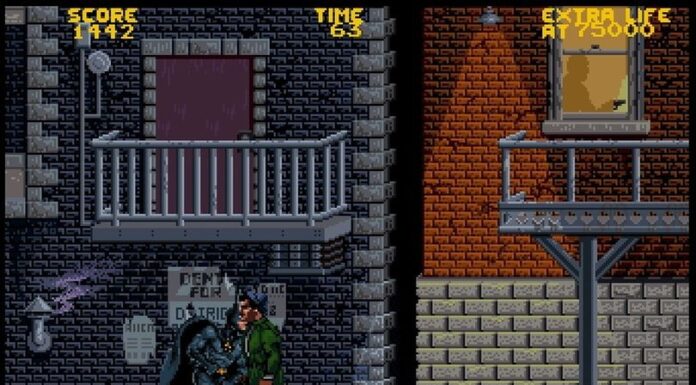
Platform: Arcade
In 1990, the beat ’em up genre welcomed a new heavyweight when Batman hit the arcades. In the era of coin-op classics, this game, rich in the ethos of Tim Burton’s Batman film, offered a chance to literally step into the boots of the Caped Crusader. Developed by Numskull Games and distributed by Atari Games, it was an arcade exclusive, designed to pull players in with its detailed graphics and action-packed gameplay.
This side-scrolling brawler placed players in the role of Batman, duking it out against the dark underbelly of Gotham City’s criminal ranks. As the game progressed, familiar villains from the movie, including The Joker, also made their appearances, much to the delight of fans.
The game differentiated itself with driving sequences featuring the iconic Batmobile and Batwing, which added variety to the beat ’em up stages. These segments were not just visually impressive but they provided unique gameplay that complemented the game’s main combat mechanics.
Upon release, Batman for the arcade received positive reception, celebrated for its faithful adaptation of the movie’s aesthetic. It stood out for its detailed environments and character animations, which skillfully replicated the dark, gothic overtones of Gotham City. The game also boasted a compelling soundtrack that kept the adrenaline pumping.
In an era where licensed games often struggled with quality, Batman was a shining exception, capturing the essence of the Dark Knight’s world and translating it seamlessly into an entertaining and immersive arcade experience.
6Batman (Japan 1990)

Platform: PC Engine
Batman (Japan 1990) for the PC Engine is one of those retro gems that takes us back to the golden era of side-scrolling action. Developed by Sunsoft, a company renowned for its knack at crafting engaging 8-bit and 16-bit era video games, this title brought the dark and brooding world of Gotham City to the compact, yet powerful, PC Engine platform, also known in North America as the TurboGrafx-16.
What made Batman stand out was not just its association with one of the most iconic superheroes but also Sunsoft’s commitment to quality. The game featured detailed sprites, atmospheric levels, and a soundtrack that perfectly captured the essence of Batman’s fight against crime. Players navigated through various stages, each culminating in a showdown against some of the Caped Crusader’s most notorious enemies, showcasing the developer’s ability to blend action with strategy.
Although Batman was primarily available on the PC Engine, its appeal transcended the platform, attracting a wide audience of fans and gamers alike. Reception-wise, the game was met with positive acclaim for its faithful rendition of the Batman universe, engaging gameplay mechanics, and overall presentation. It stood as a testament to how superhero games could be done right, balancing fan service with solid gameplay. Despite the technological limitations of the time, Batman on the PC Engine managed to capture the imagination of its players, leaving a lasting legacy in the pantheon of superhero video games.
7Batman: Return of the Joker (1991)
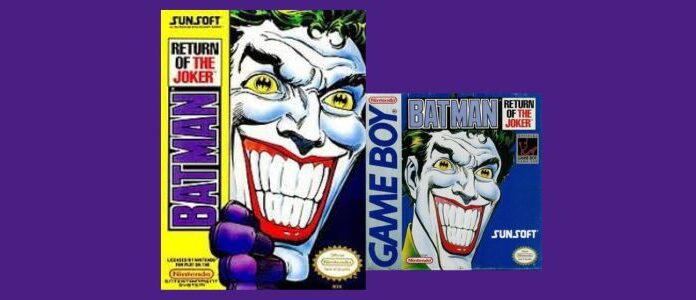
Platform: Game Boy, NES (Sega Genesis followed later)
The legacy of the Dark Knight in video gaming took a leap with Batman: Return of the Joker, released in 1991. The title was developed by Sunsoft, a company already known for its previous Batman title on the NES. Sunsoft took another crack at Gotham’s protector, presenting a game that shed the movie tie-in skin for a more comic book-inspired endeavor.
Available on both the NES and Game Boy, with a later version titled Revenge of the Joker for the Sega Genesis, Batman: Return of the Joker was a pure action platformer. Players were charged with navigating through vividly detailed stages, blasting enemies with gadgets and taking leaps that would test even the most adept of gamers.
This game distanced itself from the previous installment by embracing a futuristic and more vibrant aesthetic. Batman was equipped with a selection of projectile weapons, leading to gameplay that was more about precision shooting than the traditional brawling found in prior games.
General reception for Batman: Return of the Joker was positive. Critics and players alike praised the game for its sharp graphics, considering the limitations of 8-bit platforms like the NES. Its soundtrack was another high point, delivering an energetic pulse to accompany the on-screen action. While some lamented the shift away from the beat ’em up combat to a more Megaman-esque firearm focus, the game’s quality was undeniable, and Batman: Return of the Joker solidified its position as a standout title in the burgeoning Batman video game anthology.
8Batman Returns (1992)
Platform: NES, Sega Genesis, SNES, Sega Master System, Sega CD, Amiga, Atari Lynx, MS-DOS
When we dive into the pixelated depths of Batman Returns, we’re not just revisiting a classic movie tie-in; we’re exploring a multifaceted gaming experience that spanned across various platforms, each offering its unique take on Tim Burton’s gothic superhero sequel. Developed by different studios for each system, the video game adaptation of Batman Returns aimed to capture the dark atmosphere and complex narrative of its cinematic counterpart.
For the SNES version, Konami was the mastermind behind the development, delivering a side-scrolling beat ’em up that allowed players to step into the cape and cowl of the Dark Knight, battling through Gotham’s snowy streets and coming face-to-face with the Penguin and Catwoman. This version was praised for its faithful representation of the movie’s aesthetic, smooth gameplay mechanics, and challenging levels, making it a hit among fans.
On the Sega Genesis, Atari Lynx, and Sega CD, Batman Returns took on different forms, ranging from platforming action to driving sequences that put players behind the Batmobile’s wheel. Each version was tailored to the strengths of its respective platform, showcasing the versatility of the Batman Returns narrative across gaming genres.
The reception of Batman Returns varied by platform, with the SNES version often cited as a standout for its engaging gameplay and faithful adherence to the film’s dark tone. Though each iteration had its strengths and weaknesses, collectively, they underscored the potential for movie-based video games to offer immersive and enjoyable experiences that complement their cinematic inspirations. As a slice of early ’90s gaming history, Batman Returns remains a fascinating study in how one narrative can be reinterpreted across multiple gaming platforms, each with its unique charm.
9The Adventures of Batman & Robin (1994)
Platform: Sega Genesis, Sega CD, SNES, Game Gear
The Adventures of Batman & Robin is a classic example of ’90s video gaming done right, tapping into the heart of the iconic animated series it’s based on. Developed by a variety of studios—Clockwork Tortoise and Konami being the most notable—the game offered distinct experiences across different platforms, including the Sega Genesis, Super Nintendo Entertainment System (SNES), Sega CD, and Game Gear. Each version brought its own flavor to the table, showcasing the versatility and creativity of its developers.
On the Sega Genesis, players got a fast-paced, action-packed experience with a strong emphasis on run-and-gun gameplay. The SNES version, on the other hand, leaned more towards the strategic side, with puzzle-solving elements and a different story arc. The Sega CD version stood out with its driving levels and a rockin’ soundtrack, while the Game Gear offered a more condensed but equally engaging experience suitable for gaming on the go.
Reception of The Adventures of Batman & Robin was generally positive, with praise often directed at its faithful recreation of the animated series’ atmosphere, including its graphics and music. Each platform’s version received acclaim for playing to the strengths of its system, offering Batman fans and gamers alike a variety of ways to dive into Gotham’s action-packed adventures. Critics and players appreciated the game’s challenge, depth, and the way it captured the essence of the beloved TV series, making it a cherished title among the pantheon of Batman video games.
10Batman Forever (1995)
Platform: Game Boy, Game Gear, Sega Genesis, SNES, MS-DOS
Diving into the retro gaming vault, let’s chat about Batman Forever, a title that brings a mix of nostalgia and eyebrow-raising quirks to those who remember it. Developed by Probe Entertainment and published by Acclaim Entertainment in 1995, this game aimed to ride the wave of the movie’s success, delivering an experience that was, well, memorable in its own unique ways.
Available on a variety of platforms, including the SNES, Sega Genesis, Game Boy, and even the Sega Game Gear, Batman Forever offered fans the chance to step into the boots of Gotham’s caped crusader or his sidekick, Robin. The game attempted to blend beat ’em up mechanics with puzzle-solving elements, all wrapped up in a package that faithfully mirrored the movie’s aesthetic, thanks to the use of digitized actors for character sprites—a decision that was pretty cutting-edge at the time.
However, the reception was a mixed bag. While the ambition behind Batman Forever was clear, players often found themselves grappling with clunky controls and a confusing level design that could turn navigating through Gotham City into a bit of a chore. Critics and gamers alike were divided, with some appreciating the attempt to capture the movie’s essence, while others couldn’t get past its gameplay flaws. Despite its mixed legacy, Batman Forever remains a fascinating snapshot of mid-’90s gaming culture, embodying both the potential and pitfalls of movie tie-in video games.
11Batman Forever: The Arcade Game (1996)
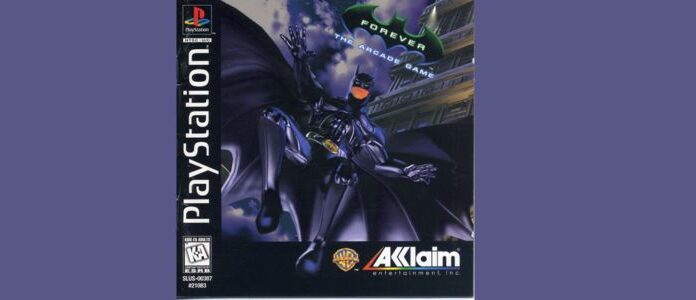
Platform: Arcade, PlayStation, Sega Saturn, MS-DOS
Ah, nostalgia, you fickle beast. Let’s dust off the memories and take a trip back to 1996 when Batman Forever: The Arcade Game swung into the scene. Developed by Acclaim Entertainment, this title swooped down onto the PlayStation, Sega Saturn, and — if you can believe it — even the PC.
Now, this wasn’t your thoughtful, brooding Batman of the modern era. Oh no, this was pure ’90s arcade brawler chaos, styled after the movie of the same name, though liberally taking creative licenses, as games of that era tended to do. Players got to slip into the boots of either Batman or Robin, pummeling their way through Gotham’s finest goons, with a visual flair borrowed straight from the silver screen’s neon-tinged aesthetic.
The reception? Well, let’s just say it was as mixed as the infamous movie itself. Some loved the fast-paced action and the opportunity to sidekick through levels with a buddy in co-op mode. Others found it repetitive and critiqued it for not bringing anything particularly revolutionary to the beat ’em up genre. Undeniably though, Batman Forever: The Arcade Game served a hearty dose of ’90s nostalgia with its side-scrolling exploits that resonate with many a bat-fan to this day.
12Batman & Robin (1998) – PlayStation
Platform: PlayStation
Batman & Robin, a video game that swung onto the scene in step with the 1997 movie of the same name, landed on shelves in 1998. Developed by Probe Entertainment and published by Acclaim Entertainment, this title attempted to capture the dark and vibrant aesthetic of the film, donning the iconic suit and gadgets of the eponymous heroes. It aimed to serve as a companion piece, expanding the movie’s narrative and offering fans a chance to delve deeper into Gotham City’s lore.
Available exclusively on the PlayStation, Batman & Robin thrusts players into the gothic world of Gotham, offering a blend of driving sections and third-person adventure gameplay. You get to patrol the city in the Batmobile, Batgirl’s motorcycle, or even glide through the air as our caped crusaders. There’s an emphasis on detective work as players need to follow clues to track down Mr. Freeze, Poison Ivy, and Bane, engaging in combat and puzzle-solving along the way.
The reception of Batman & Robin was, let’s just say, less than heroic. Critics and players found the game’s controls cumbersome and the overall experience rather unpolished. The ambitious open-world design was acknowledged, but technical issues and a lack of engaging content meant that Batman & Robin didn’t quite soar in the gaming community. Despite its attempt to immerse gamers in the world of the Dark Knight, it was often seen as a missed opportunity to build upon the caped crusader’s legacy in the gaming sphere.
13Batman: Chaos in Gotham (2001)

Platform: Game Boy Color
Diving into handheld gaming, Batman: Chaos in Gotham arrived on the scene in 2001, designed to fit snugly in the pockets of Dark Knight fans everywhere. The game was developed by Digital Eclipse and published by Ubisoft, tapping into the veins of Gotham’s perpetual conflict. With a narrative inspired by the animated series, it provided players with another pixelated avenue to experience the thrills of being Batman on the move.
This adventure was targeted at Game Boy Color owners, featuring a side-scrolling platformer style that harkened back to the classic era of gaming. Players stepped into the boots of both Batman and his trusty sidekick Robin, navigating through the twisted streets of Gotham City. The game loop had you grappling and batarang-throwing your way through levels, duking it out with a rogues’ gallery of villains like Joker, Harley Quinn, and Poison Ivy. With a utility belt full of gadgets and strategy requirements depending on the foe, it provided a compact Batman experience on the go.
Batman: Chaos in Gotham was received with a mix of reactions, nestled somewhere between mild enthusiasm and tempered critique. While it didn’t set the world on fire, the game was appreciated for its adherence to the animated series’ style and providing a Batman fix for gamers on the go. It was a serviceable title that catered well to fans of the franchise looking to tackle villainy in bite-sized play sessions.
14Batman: Gotham City Racer (2001)
Platform: PlayStation
In 2001, Batman fans were treated to a different kind of Dark Knight escapade with the release of Batman: Gotham City Racer. Developed by Sinister Games and published by Ubisoft, this title took a sharp turn from the typical beat-em-up or platformer Batman fare, choosing instead to ignite the streets of Gotham with high-speed chases. It borrowed the visage of the animated Batman series, aiming to capture the same neo-noir feel but through the fast-paced lens of a vehicular pursuit.
Batman: Gotham City Racer was revved up exclusively for PlayStation owners, putting players behind the wheel of the Batmobile as well as other vehicles from the animated series. The game offered more than 50 “episode” missions, where players chased down villains or raced to the scene of a crime. While primarily focused on driving mechanics, it also allowed players to use an assortment of Batman’s gadgets to halt the progress of notorious adversaries during high-speed chases.
However, Gotham City Racer sped past acclaim and instead met with a rather lukewarm reception from fans and critics alike. Many felt the vehicle controls were less than smooth and that the gameplay became repetitive quite quickly. While drawing from the rich lore of the Batman animated series was a positive note, the game struggled to deliver an experience that could stand out among the fleet of superhero titles available, leaving it lost in the shuffle for many gamers.
15Batman: Vengeance (2001)
Platforms: Game Boy Advance, GameCube, PlayStation 2, Xbox, PC
Batman: Vengeance swooped onto the gaming scene in 2001, brought to life by Ubisoft Montreal. The game came out swinging during a time when superhero games were popping up left and right, looking to stake its claim in the hearts of Dark Knight enthusiasts. Timed alongside the new millennium’s burgeoning Batman craze, it aimed to channel the essence of the animated series into an interactive crime-fighting experience.
Gamers could engage with Batman: Vengeance across multiple platforms: PlayStation 2, Xbox, GameCube, and even a version made its way to the Game Boy Advance. Players immersed themselves in a third-person action-adventure, navigating Gotham City’s rooftops, alleyways, and the ominous interiors evocative of the animated series’ aesthetic. With combat, stealth sequences, and even some good old-fashioned Bat-gadgetry at your disposal, the game made a valiant attempt at delivering a comprehensive Batman adventure.
Upon its release, Batman: Vengeance received a fairly positive reception. Gamers and critics alike praised the game for its faithful representation of the beloved animated series, including the voice acting and atmospheric graphics. The cinematic cutscenes and varied gameplay were also points of kudos. However, the game wasn’t free from criticism—some players found the controls and camera angles to be the kryptonite of their experience. While not flawless, Batman: Vengeance held its ground as a solid contribution to the caped crusader’s video game legacy.
16Batman: Dark Tomorrow (2003)
Released: GameCube, Xbox
Batman: Dark Tomorrow took a leap off the Wayne Enterprises skyscraper in 2003, attempting to land firmly in the landscape of superhero gaming. It was an ambitious project developed by HotGen and published by Kemco, aiming to grant players a gritty narrative-driven experience. Unlike other Batman games of the time, Dark Tomorrow was not linked to the animated series or movies, carving out its own unique storyline within the Batman universe.
The game was released for the GameCube and Xbox, featuring a combination of third-person action and stealth-based gameplay. Players donned the cape and cowl, swooping through the shadowy corners of Gotham City and using an array of gadgets to thwart the plans of the dark city’s infamous villains. With a focus on combat and exploration, it promised to take fans on an intense journey through the perils Batman faces on a nightly basis.
The reception of Batman: Dark Tomorrow, unfortunately, was about as gloomy as the Gotham it depicted. Though the game’s narrative and cutscenes were given a nod for their attempt at depth and development, the game was heavily criticized for its frustrating control scheme, poor camera angles, and overall lack of polish. These technical shortcomings overshadowed the developer’s efforts in storytelling, rendering Dark Tomorrow a bit of a dark spot in the Batman video game saga. Despite its potential, the game struggled to fulfill the expectations of the Batman fandom.
17Batman: Rise of Sin Tzu (2003)
Platforms: Game Boy Advance, GameCube, PlayStation 2, Xbox
Batman: Rise of Sin Tzu swooped into the video game arena in 2003, developed by Ubisoft Montreal. Released in tandem with the 15th anniversary of the Batman: The Animated Series, Rise of Sin Tzu aimed to captivate fans by introducing a new villain exclusively for the game, a move that set it apart from the usual trope of recurring franchise rogues.
The beat ’em up adventure was made accessible to a variety of players across the PlayStation 2, Xbox, GameCube, and Game Boy Advance. The gameplay of Rise of Sin Tzu featured classic brawling action, with players being able to choose from Batman, Robin, Batgirl, or Nightwing, each with their own set of moves and combos. The campaign mode could be tackled solo or with a friend in co-op, pitting the dynamic duo against waves of thugs before facing off with familiar foes like Bane, Scarecrow, and the titular Sin Tzu.
At release, Batman: Rise of Sin Tzu received a mix of admiration and criticism. Fans enjoyed the cooperative gameplay and the fresh face of Sin Tzu added depth to the Dark Knight’s gallery of adversaries. Yet, the game was often knocked for its repetitive gameplay and lackluster AI. While it may not have reached the heights of Arkham, Rise of Sin Tzu managed to capture some of the magic from the animated series it was inspired by, giving Batman enthusiasts another title to add to their collection.
18Batman Begins (2005)
Platforms: Game Boy Advance, GameCube, PlayStation 2, Xbox
The Batman Begins video game brought the gritty realism of Christopher Nolan’s cinematic revival to gamers in 2005. Crafted by Eurocom and published by Electronic Arts, it paralleled the film’s release, offering players a chance to step directly into the rebooted boots of the Dark Knight. The game sought to capture the film’s atmospheric tone and complex character portrayal, a leg up in the storytelling department for superhero adaptions of the time.
Available on the PlayStation 2, Xbox, and GameCube, with a portable version on the Game Boy Advance, Batman Begins blended stealth mechanics with driving segments worthy of the Batmobile’s reputation. Gameplay revolved around using fear to intimidate opponents, a noble attempt to translate Batman’s psychological tactics into a video game format. Varying levels took players from the Himalayan mountains to the grim underbelly of Gotham, piecing together gadgets, combat, and cunning to confront the Scarecrow and Ra’s al Ghul.
Batman Begins received a medley of reactions, with many praising its voice acting—boasting the film’s cast—and the engrossing narrative that stayed loyal to its big-screen inspiration. However, the appreciation for its authentic feel and cohesive story couldn’t fully mask the criticisms of its linear gameplay and less-than-challenging combat sequences. Ultimately, while not quite a revolution in the realm of superhero games, Batman Begins was considered a solid attempt at translating a movie experience into an interactive format.
19LEGO Batman: The Videogame (2008)
Platforms: PlayStation 2, PlayStation 3, PlayStation Portable, Xbox 360, Wii, Nintendo DS, macOS, PC
LEGO Batman: The Videogame burst onto the scene in September 2008, letting players step into a world where Gotham City was reimagined with the charm and playfulness of LEGO. Developed by Traveller’s Tales, this was the first LEGO game to break away from direct movie licensing, instead creating an original story set in the LEGO Batman universe. Combining the dark Gotham ambiance with the light-hearted LEGO brand resulted in an experience that appealed to enthusiasts of both.
The game was a multi-platform adventure, gracing the PlayStation 2, PlayStation 3, Xbox 360, Wii, Nintendo DS, PSP, and PC. LEGO Batman: The Videogame allowed players to control Batman, Robin, and an entire lineup of villains, each with unique abilities and gadgets across various story-driven levels. Its gameplay featured a mix of puzzle-solving, beat ’em up action, and vehicle-based levels, capturing the essence of the Batman experience through a distinctly LEGO lens.
Upon its release, LEGO Batman: The Videogame received a warm welcome for its engaging gameplay, delightful art style, and family-friendly portrayal of the usually dark Batman franchise. Its appeal to both younger audiences and die-hard Batman fans helped solidify the game as a hit, bolstering the LEGO series’ reputation for delivering fun and accessible superhero adventures. While it didn’t radically change the action-adventure genre, it stood out as a lovable and replayable entry into the expanding LEGO gaming franchise.
20Batman: Arkham Asylum (2009)
Platforms: PlayStation 3, Xbox 360, PlayStation 4, Xbox One, macOS, PC
LEGO Batman: The Videogame crashed into the gaming world in 2008, serving up a delightful brick-built version of Gotham’s hero. Developer Traveller’s Tales built upon their experience with LEGO video games to craft this playful entry into the Batman universe, combining the charm of LEGO with the dark allure of the caped crusader. This marked the first time the LEGO series tackled a franchise outside the film adaptations, flying solo with DC’s brooding defender.
This Batman game landed on multiple platforms including PlayStation 2, PlayStation 3, Xbox 360, Wii, Nintendo DS, PSP, and PC. Players could experience the iconic storylines and characters of the Batman universe re-imagined in LEGO form, complete with destructible environments and a roster of characters each boasting unique abilities. Whether driving through the streets in the Batmobile or solving puzzles with the Dynamic Duo in free-play mode, LEGO Batman: The Videogame gave a generous nod to the source material while keeping the lightheartedness of LEGO games intact.
LEGO Batman: The Videogame was met with open arms and warm smiles upon launch. Critics and gamers alike lauded the game for its humorous take on the traditionally morose Batman atmosphere, as well as its engaging co-op gameplay. While the gameplay mechanics didn’t stray far from the familiar LEGO formula, the game’s charm and polished design were more than enough to make it a hit with Batman enthusiasts and LEGO fans, proving that Gotham’s protector could indeed have a fun side.
21Batman: The Brave and the Bold – The Videogame (2010)
Platforms: Wii, Nintendo DS
Batman: The Brave and the Bold – The Videogame launched into the world of side-scrolling beat ’em ups in 2010, adding a splash of comic book color to the gaming landscape. Developed by WayForward Technologies and inspired by the cartoon of the same name, the game captured the light-hearted and slightly campy tone of the show, a contrast to many of Batman’s darker-themed video game ventures. Its release gave Batman fans of all ages a chance to team up with a roster of DC heroes in a Saturday-morning-cartoon-style escapade.
Released on the Nintendo Wii and DS, the game encouraged cooperative play, allowing a second player to jump in and fight crime alongside Batman. With gameplay that evoked the feel of classic side-scrolling action titles, players brawled through hordes of enemies and tackled creative boss battles. With a range of characters like Robin, Green Lantern, and Blue Beetle, each with their unique abilities, the game stayed true to the cooperative spirit the show was known for. (It’s probably the closest thing we’re going to get to a Blue Beetle game).
Batman: The Brave and the Bold – The Videogame was welcomed for its approachable gameplay and faithful adaptation of the cartoon’s vibe. It received praise for its vibrant art style, smooth animation, and engaging local multiplayer experience. While some found the gameplay mechanically simplistic, it was generally accepted as a refreshing, family-friendly take on the Batman franchise, highlighting the diversity of the character’s appeal across different media.
22Batman: Arkham City (2011)
Platforms: PlayStation 3, Xbox 360, Wii U, PlayStation 4, Xbox One, macOS, PC
Batman: Arkham City glided onto the gaming scene in 2011, following the critical success of its predecessor, Batman: Arkham Asylum. Developed by Rocksteady Studios and published by Warner Bros. Interactive Entertainment, the highly anticipated sequel took everything that fans adored about the original and amplified it within a sprawling, open-world super-prison brimming with Gotham’s most dangerous.
Playable on PlayStation 3, Xbox 360, and PC, with later remastered versions for PlayStation 4 and Xbox One, Batman: Arkham City expanded the scope of its gameplay to match its grand setting. The game wove together tight combat mechanics, stealth sequences, and detective work in a multi-layered plot that drew from Batman’s rich comic book history. Players could soar above the cityscape, glide into the night, and engage in free-flowing brawls, using a refined version of the original game’s combat system. The freedom to explore the city and tackle missions in varied sequences gave players the true feeling of playing as the Dark Knight.
Batman: Arkham City was met with widespread acclaim. It was praised for its compelling narrative, atmospheric setting, and highly polished game mechanics. Reviewers and gamers alike heralded it as a standout title not just within the superhero genre but in the landscape of video games as a whole. The deep immersion into Batman’s world and the satisfying blend of action, narrative, and open-world exploration ensured its place in the halls of gaming greatness.
23LEGO Batman 2: DC Super Heroes (2012)
Platforms: PlayStation 3, Xbox 360, Wii, Nintendo DS, Nintendo 3DS, PlayStation Vita, Wii U, macOS, PC
LEGO Batman 2: DC Super Heroes assembled in 2012, building on the whimsical foundation of its predecessor to deliver an even more expansive LEGO-capade. Traveller’s Tales was back at the helm, crafting a sequel that for the first time in the LEGO series added an open world to explore and voice acting to bring the characters to life. The game stretched beyond Gotham, bringing in a plethora of characters from the larger DC universe.
This brick-laden adventure was launched on an impressive array of platforms: PlayStation 3, Xbox 360, Wii, Nintendo DS, Nintendo 3DS, PlayStation Vita, and PC, ensuring that a wide audience could enjoy the experience. LEGO Batman 2 introduced players to an open-world Gotham City, loaded with puzzles to solve, criminals to catch, and blocks to build. Flying across the skyline as Superman or speeding through the streets in the Batmobile, players could enjoy the free-form exploration and switch between a cast of characters, each with unique abilities, in both the story missions and the open-world hub.
Upon release, LEGO Batman 2: DC Super Heroes received a warm reception, celebrated for its lighthearted storytelling, voice-acted cutscenes, and the vast open-world that provided a refreshing playground for DC fans. It was considered a notable step up from its forebear, giving players more freedom and options for exploration. While some criticized the game for technical hiccups and an occasionally befuddling navigation system, it remains a beloved entry that contributed to the enduring charm and success of the LEGO video game franchise.
24Batman: Arkham Origins (2013)
Platforms: PlayStation 3, Xbox 360, Wii U, PC
Batman: Arkham Origins swooped into the gaming world just in time for Halloween in 2013, serving as a prequel to the acclaimed Arkham series previously helmed by Rocksteady Studios. This time, WB Games Montréal took up the cowl, delivering a story that explored an earlier chapter of Bruce Wayne’s vigilante career against a backdrop of a cold and menacing Christmas Eve in Gotham.
The game was made available on PlayStation 3, Xbox 360, Wii U, and PC, carrying over the familiar free-flow combat and predator mechanics from the earlier Arkham titles. Arkham Origins thrust players into a Gotham City brimming with corrupt cops, iconic villains, and a bounty on Batman’s head. While the core gameplay remained much the same, offering a blend of bone-crunching combat and stealthy takedowns, the game also introduced new elements like the remote claw gadget and an expanded detective mode for crime scene investigation.
The reception of Batman: Arkham Origins was a mixed bag. While it maintained the impressive action and atmosphere of its predecessors, the absence of innovation and the presence of technical issues at launch cast a shadow on its entry. Some critics and players felt it didn’t quite escape the shadow of Arkham City, although the narrative and voice performances received praise. Ultimately, Arkham Origins was seen as a competent but not revolutionary addition to the Batman video game mythology.
25Batman: Arkham Origins Blackgate (2013)
Platforms: PlayStation Vita, Nintendo 3DS, PlayStation 3, Xbox 360, Wii U, PC
Batman: Arkham Origins Blackgate swung onto handheld devices in October 2013, positioned as a companion game to Batman: Arkham Origins. Developed by Armature Studio, the team behind this release sought to condense the Arkham experience into a form suitable for on-the-go gaming. While Blackgate mirrors the dark aesthetic of the console games, it introduces a side-scrolling perspective, aiming to blend traditional Arkham gameplay elements with the practicalities of handheld gaming.
Initially designed for the Nintendo 3DS and PlayStation Vita, Batman: Arkham Origins Blackgate later expanded its precinct to the PlayStation 3, Xbox 360, Wii U, and PC with a Deluxe Edition. The game features a 2.5D gameplay style, combining side-scrolling elements with the freedom to move in and out of the background. This title kept the series’ emphasis on combat and stealth, while also incorporating puzzle-solving and exploration within the confines of the ominous Blackgate Prison.
Upon its release, Batman: Arkham Origins Blackgate received a somewhat chilly reception. Fans of the Arkham series approached it with high expectations due to the strong reputation of its bigger siblings, only to find that the translation to a handheld format and 2.5D didn’t entirely capture the depth they were accustomed to. Critics pointed out weaknesses in the game’s navigation and combat mechanics, feeling they didn’t quite hit the mark set by the earlier Arkham successes. Nonetheless, the game was commended for attempting to bring the Arkham essence to handhelds, and some liked the innovative blend of exploration and combat in a more compact form.
26LEGO Batman 3: Beyond Gotham (2014)
Platforms: PlayStation 3, PlayStation 4, Xbox 360, Xbox One, Wii U, Nintendo 3DS, PlayStation Vita, macOS, PC
LEGO Batman 3: Beyond Gotham launched in November 2014 as the cosmic continuation of the LEGO Batman saga. Developed by Traveller’s Tales, the game maintained the series’ endearing fusion of humor and heroic action while blasting off from the streets of Gotham into the greater reaches of the DC Universe. It crafted a backdrop abundant with locations iconic to the DC lore, embracing a wide span of characters beyond the Caped Crusader.
Playable across a host of platforms—PlayStation 4, PlayStation 3, Xbox One, Xbox 360, Wii U, Nintendo 3DS, PlayStation Vita, and PC—LEGO Batman 3 allowed players to unlock and play as an ensemble cast of over 150 characters from the DC universe, each with their own abilities. Gameplay involved solving puzzles, duking it out with baddies, and swapping suits to access different powers, all with a whimsical LEGO twist. The game included traditional linear levels, as well as various open-world environments for players to explore in between the main stages.
Reception of LEGO Batman 3: Beyond Gotham was mostly positive, with fans and critics enjoying the vast character selection and intergalactic setting. The game’s humor, nods to comic lore, and family-friendly gameplay was well-received, making it another enjoyable title in the LEGO gaming series. However, some expressed that the formula was beginning to feel a bit familiar and suggested it offered little in the way of innovation for the franchise. Despite this, the game secured its place as a fun and engaging entry for both LEGO and Batman enthusiasts.
27Batman: Arkham Knight (2015)
Platforms: PlayStation 4, Xbox One, PC
Batman: Arkham Knight descended upon the gaming world in June 2015, marking the conclusion to Rocksteady Studios’ acclaimed Arkham trilogy. The game promised to deliver the most complete and immersive Batman experience to date, plunging players into a beautifully chaotic Gotham City on the brink of total anarchy. With the stakes higher than ever, Arkham Knight aimed to wrap up Batman’s journey with a climactic finale.
Touching down on PlayStation 4, Xbox One, and PC, Arkham Knight gameplay included revamped combat, comprehensive stealth mechanics, and the much-anticipated drivable Batmobile, a first for the series. Street corners and rooftops buzzed with the life of a city under siege, providing a playground for the Dark Knight’s brawls and brooding. The Arkham Knight ending, wrapped in a shroud of mystery, promised an epic conclusion to the Dark Knight’s gritty gaming saga.
Post-launch, Batman: Arkham Knight garnered a great deal of attention, receiving critical acclaim for its storytelling, presentation, and game mechanics. The addition of the Batmobile was met with mixed feelings, some feeling it a thrilling extension of Batman’s arsenal, while others criticized its overuse in certain gameplay segments. Technical issues, particularly with the PC version, led to a rocky start, yet once resolved, Arkham Knight stood as a worthy and memorable sendoff to one of gaming’s most revered interpretations of the Batman mythos.
28Batman: Arkham VR (2016)
Platforms: PlayStation VR, Oculus Rift, HTC Vive
Batman: Arkham VR emerged from the shadows in October 2016, inviting players to pull on the cowl in virtual reality. Developed by Rocksteady Studios, it was released in the wake of the Arkham Knight ending, offering a fresh perspective on the Batman universe. Although shorter than its predecessors, Arkham VR aimed to provide an intimate and immersive dive into the detective aspects of being the World’s Greatest Detective.
Initially exclusive to the PlayStation VR, with subsequent releases on Steam for HTC Vive, Oculus Rift, and Valve Index, the experience is tailored to showcase the unique capabilities of VR. The gameplay is predominantly investigative, with players standing in Batman’s boots, investigating crime scenes, and solving puzzles through hands-on interaction with the environment. The use of iconic gadgets like the Batarang became more tactile within the VR space, enhancing the connection to the Caped Crusader’s world.
The reception to Batman: Arkham VR was cautiously positive, with most appreciating the innovative VR experience that brought Gotham to life in a compelling new manner. While the length and lack of traditional combat left some desiring more, the detailed environments and opportunity to embody Batman in VR were praised as a standout feature. It was ultimately seen as a successful, albeit brief, foray into virtual reality for the Arkham series, offering fans a uniquely immersive peek into Batman’s universe.
29Batman: The Telltale Series (2016)
Platforms: PlayStation 3, PlayStation 4, Xbox 360, Xbox One, Nintendo Switch, PC, macOS, iOS, Android
Batman: The Telltale Series emerged from the shadow of the night in August 2016, opening a new chapter in the Dark Knight’s rich video game legacy. Developed by Telltale Games, this narrative-driven episodic series offered a distinct take on the Batman mythos, emphasizing the duality of living as both the billionaire Bruce Wayne and the shroud of night, Batman. It was a departure from the action-heavy gameplay of the Arkham titles, instead unfolding its drama through the lens of player-driven storytelling.
The game was released across a variety of platforms, including PlayStation 4, Xbox One, PC, as well as last-gen systems like PlayStation 3 and Xbox 360, and even extended its reach to mobile platforms. Telltale’s signature gameplay mechanics of dialogue choices, quick-time events, and episodic cliffhangers drove the experience. Players not only threw punches but also meticulously navigated the complex social and political landscapes of Gotham, their choices shaping the narrative and relationships within the game.
Upon its release, Batman: The Telltale Series was met with praise for its deep character development and plot. The ability to influence the direction of the story provided a sense of engagement that resonated with players, allowing them to craft their own version of the iconic superhero’s journey. Some critiques did surface regarding the game’s technical performance, but they generally didn’t overshadow the positive reception of its immersive storytelling and fresh take on the trials of the Caped Crusader.
30Batman: The Enemy Within (2017)
Platforms: PlayStation 4, Xbox One, Nintendo Switch, PC, macOS, iOS, Android
Batman: The Enemy Within swung into the spotlight in August 2017, continuing the narrative path carved out by Batman: The Telltale Series. Developed by Telltale Games, the second season deepened the interactive storytelling venture, presenting players with another round of tough moral dilemmas and the dark political underbelly of Gotham City. The game doubled down on the complexities of Bruce Wayne’s double life, pitting him against a new set of threats and uneasy alliances.
Available on multiple platforms, including PlayStation 4, Xbox One, PC, and mobile devices, The Enemy Within sustained Telltale’s episodic format and choice-driven gameplay. Players were thrust into both the detective work and social maneuvering expected of Batman and Bruce Wayne, affecting the narrative outcome with their decisions. Quick-time events punctuated the action sequences, while investigations and interpersonal relationships formed the heart of the game’s mechanics.
The game received a broadly positive reception, with particular applause given to its narrative depth, character development, and the empathetic portrayal of its cast—most notably the complex relationship between Batman and the nascent Joker. However, it wasn’t without critique—some players noted occasional pacing issues and technical hitches. Despite these hiccups, Batman: The Enemy Within was lauded for continuing the mature, character-driven storytelling approach to the Batman universe that fans had come to appreciate in the episodic format.
Now that you’ve taken a look at the entire history of Batman video games, you might want to check out our list of 6 ideas for the next Batman game.
